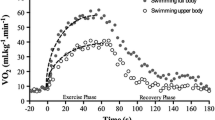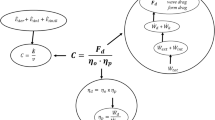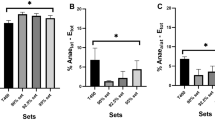Summary
Oxygen uptake was measured on four male subjects during sculling gondolas at constant speeds from ∼1 to ∼ 3 m · s−1. The number of scullers on board in the different trials was one, two or four. Tractional water resistance (drag,D, N) was also measured in the same range of speeds. Energy cost of locomotion per unit of distance (C, J·m−1), as calculated from the ratio of O2 uptake above resting to, increased with v according to a power function (C=155.2·ν 1.67;r=0.88). AlsoD could be described as a power function of the speed:D=12.3·ν 2.21;r= 0.94). The overall efficiency of motion, as obtained from the ratio ofD toC increased with speed from 9.2% at 1.41 m· s−1 to 14.5% at 3.08 m·s−1. It is concluded that, in spite of this relatively low efficiency of motion, the gondola is a very economic means. Indeed, at low speeds (∼ 1 m·s−1), the absolute amount of energy for propelling a gondola is the same as that for waking on the level at the same speed for a subject of 70 kg body mass.
Similar content being viewed by others
References
Celentano F, Cortili G, di Prampero PE, Cerretelli P (1974) Mechanical aspects of rowing. J Appl Physiol 36:642–647
di Prampero PE (1984) I record del mondo nella corsa piana. Riv Cult Sportiva 3:3–7
di Prampero PE (1986) The energy cost of human locomotion. Int J Sports Med 7:55–72
di Prampero PE, Cortili G, Celentano F, Cerretelli P (1971) Physiological aspects of rowing. J Appl Physiol 31:853–857
di Prampero PE, Pendergast DR, Wilson DW, Rennie DW (1974) Energetics of swimming in man. J Appl Physiol 37:1–5
di Prampero PE, Cortili G, Mognoni P, Saibene F (1976) Energy cost of speed skating and efficiency of work against air resistance. J Appl Physiol 40:584–591
di Prampero PE, Cortili G, Mognoni P, Saibene F (1979) Equation of motion of a cyclist. J Appl Physiol 47:201–206
Margaria R (1938) Sulla fisiologia, e specialmente sul consumo energetico, della marcia e della corsa a varie velocità ed inclinazioni del terreno. Atti Acad Naz Lincei 7:299–368
Margaria R, Cerretelli P, Aghemo P, Sassi G (1963) Energy cost of running. J Appl Physiol 18:367–370
Pendergast DR, di Prampero PE, Craig AB Jr, Wilson DR, Rennie DW (1977) Quantitative analysis of front crawl in men and women. J Appl Physiol 43:475–479
Pendergast DR, Bushnell D, Wilson DW, Cerretelli P (1989) Energetics of Kayaking. Eur J Appl Physiol 59:342–350
Pugh LGCE (1971) The influence of wind resistance in running and walking and the mechanical efficiency of work against horizontal or vertical forces. J Physiol (Lond) 213:255–276
Pugh LGCE (1974) The relation of oxygen intake and speed in competition cycling and comparative observation on the bicycle ergometer. J Physiol (Lond) 241:795–808
Shames IH (1982) Mechanics of fluid. McGraw-Hill, New York, p 278
Author information
Authors and Affiliations
Rights and permissions
About this article
Cite this article
Capelli, C., Donatelli, C., Moia, C. et al. Energy cost and efficiency of sculling a Venetian gondola. Europ. J. Appl. Physiol. 60, 175–178 (1990). https://doi.org/10.1007/BF00839154
Accepted:
Issue Date:
DOI: https://doi.org/10.1007/BF00839154




